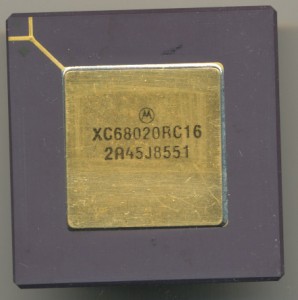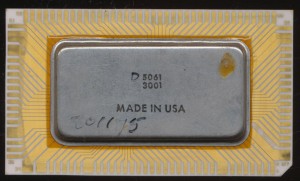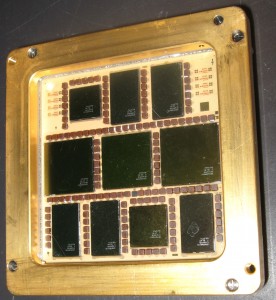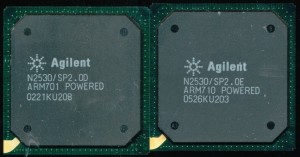March 28th, 2014 ~ by admin

1985 production 68020 ‘XC’ denotes a not fully qualified device.
In 1979 Motorola wow’d the world with the introduction of the MC68000 MACSS (Motorola Advanced Computer System on Silicon). One of the first single chip 32-bit processors. In 1982 the design was upgraded and revised, and released as the 68010. Performance wasn’t that much better then the original 68k so it saw much smaller adoption.
In 1984 Motorola continued the 68k line with the 68020. Speed was greatly improved, up to 33MHz. It was originally made on a 2 micron HCMOS process, allowing the design to use 200,000 transistors and integrate additional addressing modes, co-processor support, and multi-processor support.
The Swedish Computer archeology blog Ehliar has a nice article and die shots on its architecture and design. Check it out.
March 18th, 2014 ~ by admin

HP D5061-3001 – 10MHz 24,000 Transistors
40+ Years after computer processors began to be made, there are several that stick in peoples minds as ‘the greats’ as being somehow more important then others. Processors such as the Intel 4004, the MOS 6502 of Apple fame, and the Motorola 6800 have taken histories podium as the most important.
The truth, however, is a bit different, yet no less exciting. There are those processors that at their time, were vastly ahead of their time, such technological marvels that they continued to be competitive for a decade, impressive today, nearly unheard of in the 1970’s. Some of these processors never saw wide use in PCs, such as the 1802 or SMS300 yet were remarkable. Still others were designed not to be mass market, or to be licensed but to satisfy a company’s internal needs for a processor to power their equipment. These in house designs were every bit as impressive as the competition but since they were used by their creators alone, they faded into obscurity. One such example was the Bell Labs BELLMAC-8, designed by, and for Western Electric. They were not alone however…
Read More »
March 11th, 2014 ~ by admin

IBM z800 MCM
Mainframes are the workhorses of the computing industry. They process transactions for about every industry, and handle the brunt of the economy. Their MTBF (Mean Time Between Failures) is measured in decades (typically 20-50 years). A comparison to a home computer is hard to make, they are in an entirely different league, playing an entirely different game.
Data Intense vs. CPU Intense
Mainframe processors such as these work in what is referred to as ‘Data Intensive’ computing environments. This is different from multi-cored processing that focuses on ‘CPU Intensive’ computing. CPU intense has a relatively small data set, but most perform a lot of work on that set of data, or do the same instruction on a set of data (such as graphics). CPU Intense processing can often be sped up with the addition of more processing cores. Data Intense processing does not see as much benefit from adding cores. Its biggest bottleneck is accessing the data, thus the System z tends to have VERY large caches, and very high bandwidth memory. They typically operate on transactional type data, where the processing has to operate in a certain order (A has to be done before B which has to finish before C etc).
IBM was one of the first, and continues to be one of the largest suppliers of such systems. Starting with the System/360 introduced in 1964 to the zSeries today. The zSeries was first launched in 2000 with the z900, a significant upgrade from the System/390. Data addressing was moved to 64-bits (from 31 bits) yet backwards compatibility (all the way back to the 360) is maintained. The z900 ran at 775MHz and was built with a 35 die MCM containing 20 Processing Units (PUs) and 32MB of L2 Cache.
Read More »
March 6th, 2014 ~ by admin

ARM 701 mis-print on the left
We recently received several Remote Server management cards, powered by the Agilent (spun off of HP in 1999) N2530 SoC. This SoC provides the processing for remotely administering, and managing servers. At its hearts is an ARM processor running at 33MHz. Proudly marked on the chip, is ‘ARM 701 POWERED.’ There is one problem, there never was an ARM701 processor core. The N2530 is in fact powered by an ARM710. A typo was made when marked the Rev D chips, and later fixed on the Revision E. I have not yet received an example of a Rev C (or earlier) to see if they too have this error, but E and later certainly did not. The Agilent N2530 was used for many years in the early 2000’s on cards by Dell, Fujitsu, and IBM (and likely others). Essentially forming a computer within a computer, these cards often had their own graphics support (ATI Mobility Radeon, among others) as well as support for CD-ROMs, hard drives, LAN (for access) and everything else you would find in a stand alone computer. Typically they could remote start, reboot, and power down servers, all over a network connection.





